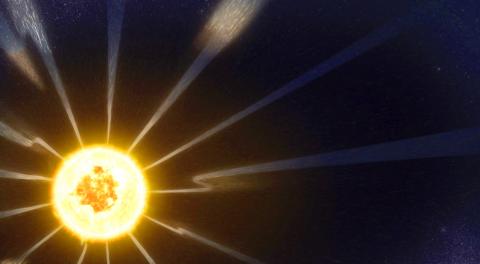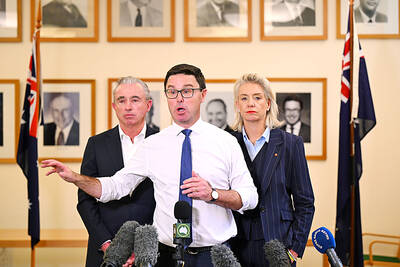NASA’s Parker Solar Probe, having survived its closest encounter so far with the sun, has sent back a “spectacular trove” of data on its corona, the super-hot outer edge of the sun’s atmosphere, scientists said on Wednesday.
The car-sized probe, launched in August last year, is to travel within about 6 million kilometers of the sun’s surface during a series of fly-bys at other distances and trajectories over seven years.
It is hoped it will allow a better understanding of the solar wind and electromagnetic storms, which can cause chaos on Earth by knocking out power grids.

Photo: AP
One puzzle concerns the corona itself, which at 1 million degrees Celcius is many times hotter than the sun’s surface at 6,000°C, when it would normally be expected to cool the further from the heat source.
“So the corona finds a way to heat up. We are looking at the physical processes which allow that to happen,” said Alexis Rouillard at France’s National Centre for Scientific Research and coauthor of one of four reports on the probe’s initial findings published in the journal Nature.
“Even with just these first orbits, we’ve been shocked by how different the corona is when observed up close,” said Justin Kasper, a professor of climate and space sciences and engineering at the University of Michigan.
A summary by the University of Michigan said that it had been thought that oscillations in the sun’s magnetic field might have caused the corona to heat up and were expecting to get data to confirm that.
Instead, they reported much more powerful, “rogue” magnetic waves strong enough to switch the direction of the magnetic field completely that might be the energy source for the corona.
Scientists were also surprised by what they found about the acceleration of the solar wind, the outward stream of protons, electrons and other particles emanating from the sun.
It was known that closer in, the sun’s magnetic field pulls this wind in the same direction as its rotation, so the team expected this effect would weaken further out.
“To our great surprise, as we neared the sun, we’ve already detected large rotational flows — 10 to 20 times greater than what standard models of the sun predict,” Kasper said. “So we are missing something fundamental about the sun and how the solar wind escapes.”
“This has huge implications. Space weather forecasting will need to account for these flows if we are going to be able to predict whether a coronal mass ejection will strike Earth, or astronauts heading to the moon or Mars,” he said.

BACKLASH: The National Party quit its decades-long partnership with the Liberal Party after their election loss to center-left Labor, which won a historic third term Australia’s National Party has split from its conservative coalition partner of more than 60 years, the Liberal Party, citing policy differences over renewable energy and after a resounding loss at a national election this month. “Its time to have a break,” Nationals leader David Littleproud told reporters yesterday. The split shows the pressure on Australia’s conservative parties after Prime Minister Anthony Albanese’s center-left Labor party won a historic second term in the May 3 election, powered by a voter backlash against US President Donald Trump’s policies. Under the long-standing partnership in state and federal politics, the Liberal and National coalition had shared power

CONTROVERSY: During the performance of Israel’s entrant Yuval Raphael’s song ‘New Day Will Rise,’ loud whistles were heard and two people tried to get on stage Austria’s JJ yesterday won the Eurovision Song Contest, with his operatic song Wasted Love triumphing at the world’s biggest live music television event. After votes from national juries around Europe and viewers from across the continent and beyond, JJ gave Austria its first victory since bearded drag performer Conchita Wurst’s 2014 triumph. After the nail-biting drama as the votes were revealed running into yesterday morning, Austria finished with 436 points, ahead of Israel — whose participation drew protests — on 357 and Estonia on 356. “Thank you to you, Europe, for making my dreams come true,” 24-year-old countertenor JJ, whose

A documentary whose main subject, 25-year-old photojournalist Fatima Hassouna, was killed in an Israeli airstrike in Gaza weeks before it premiered at Cannes stunned viewers into silence at the festival on Thursday. As the cinema lights came back on, filmmaker Sepideh Farsi held up an image of the young Palestinian woman killed with younger siblings on April 16, and encouraged the audience to stand up and clap to pay tribute. “To kill a child, to kill a photographer is unacceptable,” Farsi said. “There are still children to save. It must be done fast,” the exiled Iranian filmmaker added. With Israel

Africa has established the continent’s first space agency to boost Earth observation and data sharing at a time when a more hostile global context is limiting the availability of climate and weather information. The African Space Agency opened its doors last month under the umbrella of the African Union and is headquartered in Cairo. The new organization, which is still being set up and hiring people in key positions, is to coordinate existing national space programs. It aims to improve the continent’s space infrastructure by launching satellites, setting up weather stations and making sure data can be shared across